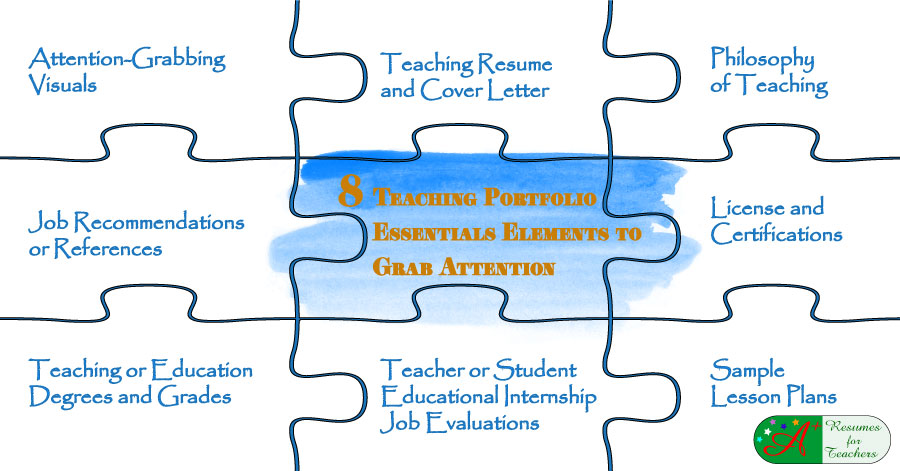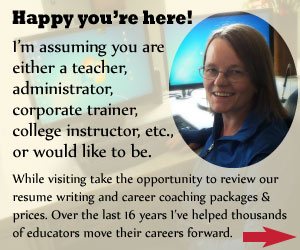8 Teaching Portfolio Essential Elements to Grab Attention
Is your teaching portfolio current and organized and compiled to show your value and set you apart from other candidates? The hiring authority deciding whether or not to interview you could have several portfolios in front of them.
What steps have you taken to ensure your portfolio grabs the reader's attention and entice them to read more?
If you cannot list five ways in which your portfolio stands out from the crowd and says, 'Look at me!,' then read on.
Teachers seeking jobs in today's market need to use every tool at their disposal to secure a teaching job. Strong teaching portfolios are one of the most valuable tools that a teaching candidate can possess.

Teaching Portfolio Objectives
It is essential to understand the benefits of showcasing your creative work to advance your career. Before assembling your portfolio focused on teaching experiences, write down what you want it to achieve.
A skillfully constructed teacher's portfolio should:
- Demonstrate your ability as a teacher
- Communicate your passion for education
- Show how you successfully engage students
- Describe how you will help schools meet key performance metrics: an increase in math and reading scores, improved parent satisfaction, and so on.
- Allow prospective employers to envision how effective you will be as a teacher instructing within their classroom.
Wherever possible, evidence should be provided to demonstrate your teaching effectiveness.
Teacher Portfolio Contents and Organization Tips
Attention-Grabbing Visuals
In today's multimedia world, a rich set of tools provide the opportunity to design an educational portfolio that stands out. A video introduction on the first page of an electronic portfolio is an example of an effective visual engagement tool. Images, animated images, and icons can jump off a page.
Ensure each visual reflects at least one of your core objectives stated above: a short video clip of you engaging students in the classroom, a short video slideshow of performance reports profiling impressive achievements (e.g., boosting Math scores by 10%). Keep the presentation and color scheme conservative to avoid a clash of tastes. As a guide, use color schemes appropriate for a corporate report.
Aside from the list below there are other important elements to include in your artifacts binder. These sections are a table of contents, letters of recommendation, thoughts and examples of classroom management, and any professional development you completed. Ensure that all the parts of the binder are professional, relevant, and that they add value to your candidacy as a new hire.
Teacher Resume and Cover Letter
Make the match! Your first or second sentence should paraphrase why you are the perfect job match – experience, certifications, teaching philosophy. Align your skills and experience with those asked for in the job description. Now address each of these claims with evidence and ideally link it to performance improvement – yours, the students and the schools. Quantitative evidence is the most influential.
- Did you improve English grades in one semester?
- Were you able to increase class attendance?
- Successfully trial a new teaching method for children with learning challenges, which is currently being used in five schools?
Qualitative examples should be impactful. Avoid unproven platitudes. Stating that you are an empathetic and engaging teacher is not enough. Each candidate has stated this!
Concrete teaching examples will prove to be useful in gaining attention.
Do you remember the teaching program in which teachers would bring babies into the classroom to teach empathy? The educators and schools have become globally recognized for their advanced teaching methods.
Be sure to include an up-to-date teacher resume and letter of intent in your teaching portfolio and bring extra copies to interviews.
Teaching Philosophy
This critical section could put the reader to sleep or place you on top of the candidate list. A philosophy of teaching should address your motivation, strategies, and objectives. In several paragraphs, outline the principles you consider to be important in educating students. This well-thought out paper should communicate your thoughts and beliefs as a teacher. The statement is an opportunity to provide potential employers insight into your personal approach to teaching.
To avoid the repetitive language used in these statements, ensure yours is from the heart and frame it in the context of your daily teaching experience.
Tell a story. How you apply this philosophy in practice should be demonstrated throughout your portfolio. Reinforcing your teaching philosophy through your portfolio and daily teaching practice will help you avoid writing a generic statement. Start by listing your principles, with practical examples of how you implement each one in your teaching practices. Start by listing your principles, with practical examples of how you implement each one in your teaching practice. Follow these writing tips to create an impressive statement.
License and Certifications
Place your most current license and certifications in your portfolio to ensure you have these important documents on hand should the interviewer want a copy. Consider submitting them with the initial application to avoid having your application sidelined in a pending file.
It also gives the prospective employer the opportunity to review the specifics of your license so they can determine whether or not you would be qualified for the open position. Preface your documentation with an eye-catching, correctly formatted cover letter, or even big bold bullet points, highlighting distinguishing details: graduating with honors, placement on Dean's lists, special qualifications and trainings and so on. Such factors distinguish you from other candidates and should jump out at the reader, not be lost in a mound of papers.
Teaching or Education Degrees and Grades
Your teaching portfolio should include all passing test scores, regardless of the quality. If you do not include certain test scores, it may appear you have something to hide. Even if your results on the test were not great, as long as you passed, you should include the documentation. It is common practice to be asked to justify a low mark in a short written statement. Avoid using a negative tone or over-explaining yourself. Many candidates write a dreary letter about the negative experiences that interrupted their studies.
A candidate with a positive, optimistic tone will leave a positive impression:
'Although being asked to serve as chair of ABC Club's busy events committee left less time to prepare for my English written and oral exams, I could never replace this invaluable opportunity. It has enhanced my leadership expertise, and polish my verbal and written English language skills! I am enthusiastically preparing to rewrite my English exams.'
Job Recommendations or References
If is advisable to solicit recommendation letters from college instructors and other educators or administrators you have worked with in the past. Quite frequently, schools will not hire you without recommendations, so save yourself time and have them prepared in advance allowing you to provide them upon request.
Teacher or Student Educational Internship Job Evaluations
Include samples of past evaluations you have received either during student teaching or in other teaching jobs. Think like a salesperson – performance, performance, performance! Hard numbers have influence. First, highlight any quantitative achievements, and then qualitative. Do not include negative evaluations; the prospective employer does not know how many times you have been evaluated.
Providing a collection of evaluations in your portfolio of teaching accomplishments will show consistency in performance. Informal job performance measurements can be the most effective. One teacher profiled a special learner's progress from a D to B student in one semester and the teaching methods used to support this outcome on one page with four engaging visuals. What are other ways can you use to demonstrate improvements in teaching, learning and/or grading?
Sample Lesson Plans
One of the most important elements in any quality teaching portfolio is an assortment of sample, quality lessons. Including student-focused, standards-based lessons in your portfolio will impress interviewers and allow them to see you as an organized and efficient teacher. Associate concrete teaching outcomes with the lessons.
Demonstrate how you are improving teaching and learning.
- Have you used technology in innovative ways in the classroom?
- Are your students mobile learners utilizing tablets and Smart Phones?
- Did you develop a new textbook, workbook or course work?
- Extracurricular activities should be included in your portfolio.
- Did you start a sports activity program over the lunch hour?
- Organize or speak at conferences/seminars?
- Did you have work published in teaching journals?
Here are more ideas on how to organize your teaching portfolio and what to include in it.
A useful exercise is creating a matrix of achievements (e.g., academic, classroom teaching, and extracurricular activities) and referring back to it as you develop job applications. Subheadings under classroom teaching may include Classroom Technology and Innovative Teaching Programs.
A quality teaching portfolio is your most valuable tool in obtaining a teaching job. Take time to assemble one now so that you have it ready when opportunity knocks. Strive for a complete portfolio to avoid being placed in the dreaded pending pile.
The most common left out details are references and copies of certificates and licenses. Interviewing will move forward without you with candidates who have all their ducks in a row.
If you require more information or have any questions - Contact Candace via email or call toll-free 1-877-738-8052. Review our services and pricing to get started to creating the perfect teaching portfolio.

